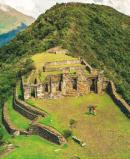Choquequirao. Machu Picchu is Sacred Sister
AT 4,000 METERS ABOVE SEA LEVEL, IN THE MIDDLE OF THE JUNGLE, VISITORS CAN MAKE OUT THE BREATHTAKING TRACES OF ONE OF THE LAST STRONGHOLDS OF THE INCA RESISTANCE IN PERU. IN 2017, THE SITE DESERVEDLY TOPPED THE LIST OF LONELY PLANET’S BEST IN TRAVEL IN THE REGIONS CATEGORY
The grayish steps look blurry under the feet of the visitor on his way to the top. Listen to roaring sound of the waterfalls and watch the Andean landscape from above: tree-carpeted cliffs, the jungle of Cusco and the snow-covered skirts of Salkantay and Padrayoc. The Inca construction seems to go back in time when the last Vilcabambas went to the square where the sun used to be worshipped and crossed the cobbled streets and the rectangular kullankas. Choquequirao is the aboriginal beauty of a Peruvian land where and history share the same space. Located some 4,000 meters above sea level.
What is now considered an archaeological park was back in the day one of the last strongholds of the Inca resistance against the Spanish colonization in 1535. Then, Cusco had been besieged and its inhabitants found shelter in the cities of the Vilcabamba region. Eventually, they called Choquequirao their home until the capture and execution of their leader, Tupac Amaru I.
Featuring a wide assortment of ecological zones and abundant flora and wildlife, the citadel is marked by contrasting stone buildings that melt perfectly into the majestic ecosystem. Visitors can take a closer look at endemic rodents and the local vizcachas, pumas, condors, Andean foxes and bears, as well as rock roosters –Peru’s national bird- all in their natural habitats. Mosses, lichen, begonias, giant ferns, ichus and a great variety of orchids draw the greenery of the citadel’s surrounding landscape.
Its strategic location right between the Amazon and the imperial city of Cusco turned this place into an important cultural and religious enclave where the Incas protected their idols of gold and silver, as well as cherished pieces of jewelry and ceramics.
Even though 70 percent of the city is currently covered under a thick blanket of foliage and many of its areas are now buried, Choquequirao reveals itself as a genuine lost city of the Incas. In the 18 square kilometers unearthed by archaeologists, the citadel allows visitors to witness the culture of that ancient town that remains a deep-down part of the region.
Hidden Treasures
The Choquequirao Archeological Park is still riddled with legends about hidden treasures. The lavish stepped construction with its two-story enclosures, staircases, channels, plazas, bridges and granite altars got a name of itself as “Machu Picchu’s Sacred Sister”.
On their platforms, similar to a large greenish carpet and overlooking the snow-capped Quory Hauyrachina, visitors can observe the 22 “Flames of the Sun” carved in stone, as the animal that symbolizes the city. Up in those hills, ancient dwellers used to grow corn, cocoa, coca, coffee and fruit trees.
Its convoluted location protected it for decades from the Spanish colonizers. Even today, reaching that point is quite an adventure that takes a two-day hike. With no more baggage than a backpack and all necessary provisions stashed in it, visitors must travel 60 km up in the mountain and cross one of the world’s deepest canyons formed by the Apurimac River.
The Archaeological Park is visited by approximately 20 tourists on a daily basis, though that figure could be stretched out to 30 during the high-peak season. In coming years, there are plans in the offing to build a cable car which will transport as many as 400 vacationers every hour from Choquequirao to the town of Kiuñalla, in a 15-minute drive.
But while this streamlining and modernizing moment comes in, many will continue to venture out there and enjoy the ecstasy of widening the lungs and the soul with this paradise of history and nature. In the same breath, they will for sure pay reverence for the sacred traces of one of the most stunning indigenous cultures the Americas ever had.





























































































































